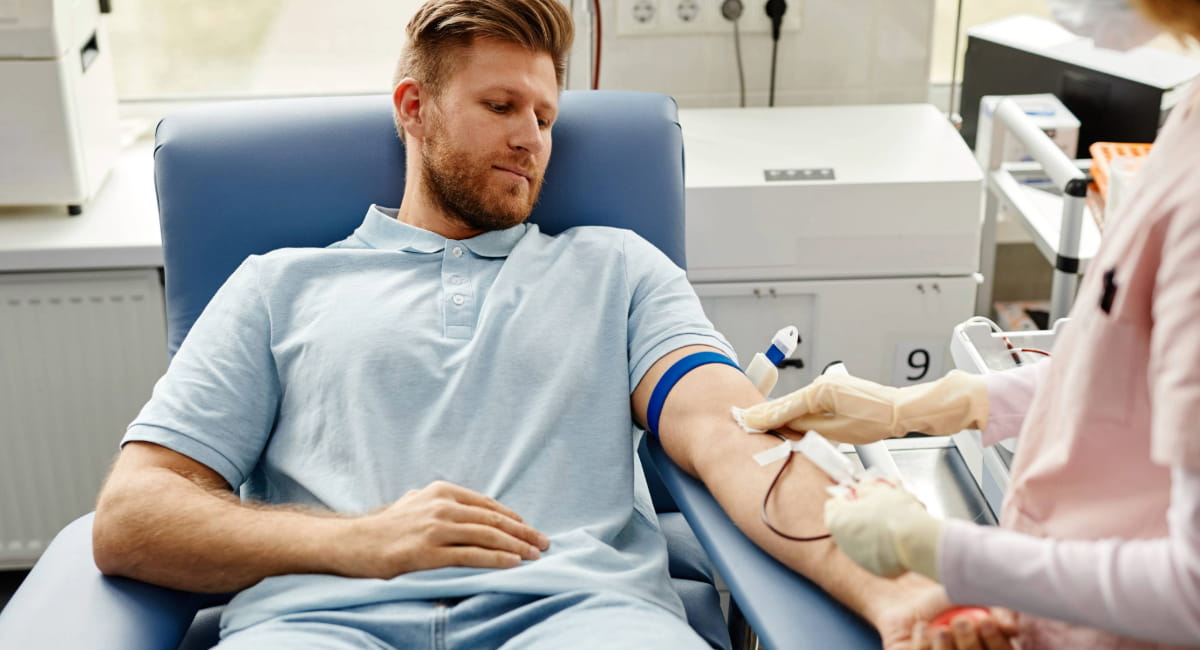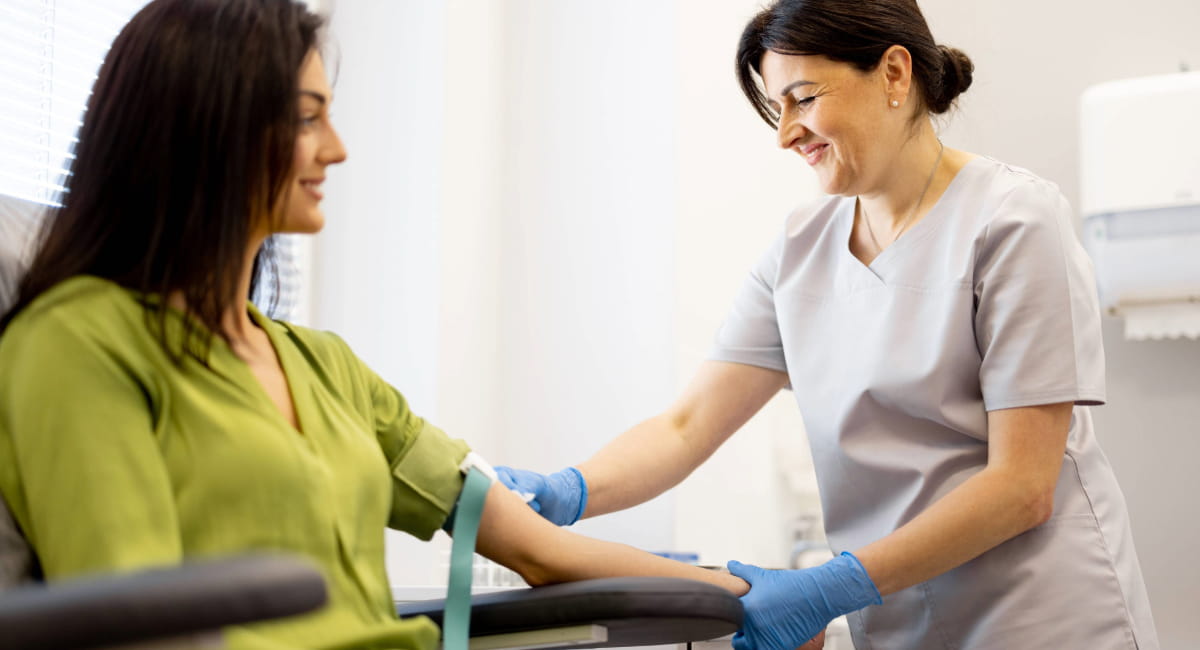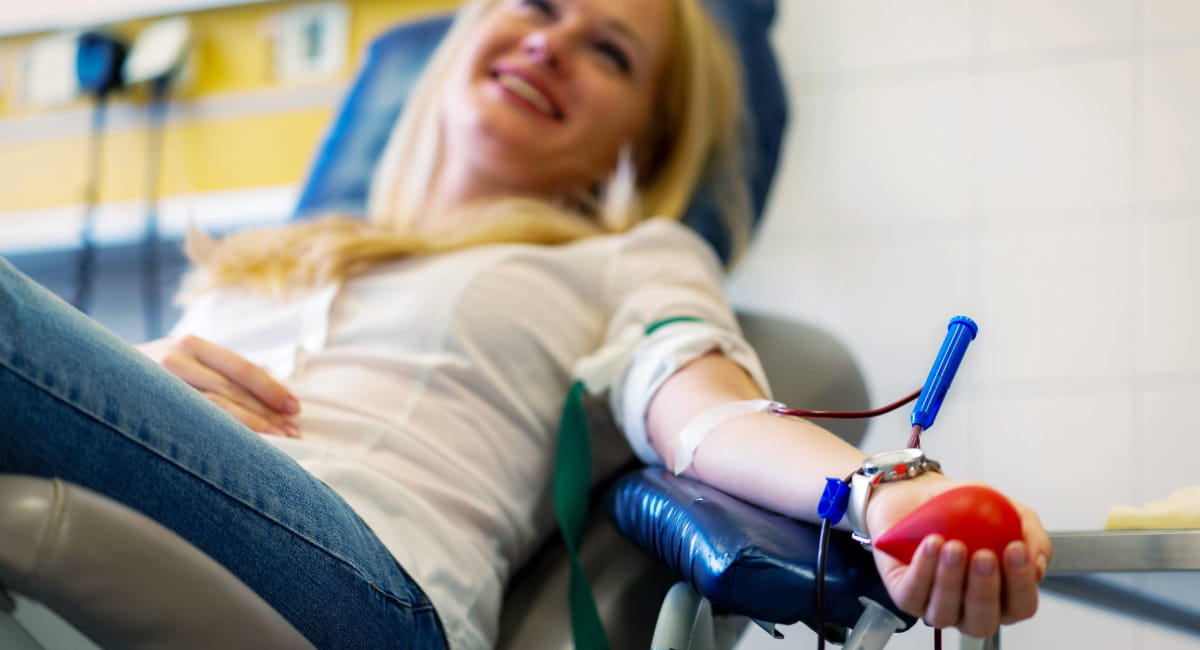“Donating blood is a small act that makes a massive difference. If you’ve ever thought about doing it, please do so.”—Dr Patrick Capon, Australian Red Cross Lifeblood
Key points
- One blood donation can save up to three lives, supporting patients with cancer, trauma injuries and chronic illnesses.
- One in three Australians will need blood in their lifetime, but only one in 30 currently donates.
- Giving blood is simple, safe and deeply rewarding—and World Blood Donor Day on 14 June is the perfect time to get involved.
Somewhere in Australia, someone’s life is about to be saved by a stranger they’ve never met. It might be a new mother. A cancer patient. Or a trauma survivor.
How will they be saved? By a blood donation, which Australian Red Cross Lifeblood says someone in Australia will need every 18 seconds. And demand is rising fast, with Lifeblood estimating it needs more than 33,000 donations each week to meet hospital demand.
“We’re experiencing the highest demand for blood we’ve seen in 12 years,” says Dr Patrick Capon from Lifeblood. “That’s largely due to a growing and aging population, and better diagnosis of conditions that rely on plasma.”
Giving blood isn’t just an urgent and necessary way to help the community—it also feels great. Just ask Tony Ventre. A few years ago, the Victorian grandfather was driving to Shepparton when he heard a radio appeal for blood donors.
“I thought: I’ve got plenty of blood—and one day my kids or grandkids might need it, and I would hope other people would donate for them,” Tony recalls. “So I went to the blood bank and said I wanted to donate.”
That day, Tony discovered that blood donation is one of those rare acts where you get just as much as you give, and this can have a positive effect on your wellbeing.

How a single donation can save multiple lives
While trauma care often comes to mind, donated blood plays a far broader role in modern healthcare. As Patrick explains, that’s because blood is made up of three key components:
- Red cells: These cells carry oxygen and are often used during surgeries or to treat anaemia.
- Plasma: There are 18 ways plasma can help, including people with burns, serious illnesses, or protecting young babies.
- Platelets: Vital for cancer patients to protect them from spontaneous bleeds.
“These components are separated out after your donation,” says Patrick. “So your red cells might go to someone in heart surgery, your plasma to someone with an autoimmune condition to help protect them from common viruses, and your platelets to someone going through chemotherapy. All from one donation.”
Beyond the lifesaving impact, donating blood is a form of volunteering that fosters a sense of purpose and community connection – all important elements in achieving real wellbeing. According to the Australian Unity Wellbeing Index, a 24-year study into the wellbeing of Australians conducted in partnership with Deakin University, individuals who engage in volunteering activities often experience higher levels of wellbeing and life satisfaction.
“Probably my favourite part of the process is when you get a text message, about a week after you donate, telling you how many people your blood has saved,” says Tony. “That gives you a real buzz. My blood gets sent as far as South Australia and Adelaide, and to most hospitals around Victoria, and I recently worked out that I’ve saved over 100 lives, which is fantastic.”
Now about to make his 25th donation, Tony only wishes he’d started doing it earlier.
“I’m sorry I didn’t do it when I was a lot younger. But I really enjoy donating blood and knowing that it’s going to help somebody, and I want to keep doing it for as long as I can.”
Blood, plasma, platelets—what’s the difference?
Not all donations are the same. Depending on your eligibility and how much time you have, you can give:
- Whole blood: This is the most common type of donation and includes red cells, plasma and platelets. It takes about 10 minutes to donate (the whole process takes about an hour), and you can donate every 12 weeks.
- Plasma: Collected via a special machine that separates your blood, keeps the plasma component and returns everything else to you. Plasma is used to treat over 50 medical conditions, and you can donate it every two weeks.
- Platelets: Also collected by a separation process. Platelets are essential for patients undergoing chemotherapy or recovering from major surgery, and you can donate them every two weeks.
“Plasma is especially valuable because it’s used in so many different treatments,” says Patrick. “And because we return your red cells, you can donate it more often. I’ve donated plasma quite a few times myself, and it’s pretty awesome to watch the colours change as they separate it out—the plasma turns out a yellowy-gold.”

Why blood types matter, especially in emergencies
While all blood types are needed, some play especially critical roles in emergency care.
“O-negative red cells are the universal donor,” explains Patrick. “They can be given to anyone, which makes them vital in trauma situations when there’s no time to test a patient’s blood type.”
On the flip side, AB plasma is the universal plasma type and can be safely transfused to anyone needing plasma support—often patients with immune deficiencies or burns.
But, as Patrick is quick to point out, “The best blood is always the same type as the patient’s. That’s why we need a wide, diverse pool of donors, with all blood types represented.”
You can check out the current supply levels of your blood type on the Lifeblood website. If you don’t know your blood type before donating, don’t worry. Lifeblood will let you know after your first donation.
Who can donate blood?
“Blood can be needed by any Australian, and it’s a bit of a numbers game,” says Patrick. “Around one in three people are going to need blood in their lifetime, but only one in 30 will donate blood—so you can see there’s a bit of a mismatch there.”
He adds that Lifeblood estimates that more than half of Australians are eligible to give blood, and that Lifeblood has been working hard to update eligibility requirements, making donating more accessible than ever. For example:
- Aged 18–75 and feeling well? You’re in the donation sweet spot. And if you’ve donated regularly before turning 75, you can keep going past that age.
- Got a tattoo? If it was done in a licensed parlour in Australia, you can donate blood just one week later, and you can give plasma immediately afterwards, says Patrick.
- Been to the United Kingdom between 1980–1996? Great news: the former “mad cow” disease restriction has now been lifted, and you are eligible to donate.
- Expanded plasma eligibility coming soon. Later in 2025, more Australians will be eligible to donate plasma, regardless of some past restrictions regarding sexual activity.
Curious about that last change?
“Previously, there were a lot of people who were not able to donate blood because of their sexual activity,” explains Patrick. “But now new data is coming out, and the research has shown that HIV has been declining in Australia over the past 10 years. Plasma also undergoes a different type of processing called ‘pathogen inactivation’. That’s why we’re looking to expand eligibility in that area, and we are very excited to see this change, because it’s been a long time coming.”
If you're still unsure whether you can donate, Lifeblood’s website has a quick eligibility quiz, or you can call 13 14 95 to speak with a medical team member directly. Patrick also recommends having a chat to your GP if you have any concerns, particularly if you know you tend to have lower iron levels.
“We also have a recommendation on our website for female donors, aged 18 to 45, that they look at iron supplementation after donation, just to help those levels recover,” he says.

What to expect, and how to get started
If you’ve never donated before, it’s normal to feel a bit unsure. But regular donors like Tony say the experience is simple, safe and surprisingly satisfying.
“The only bit I was nervous about was using the little tablet to fill in the questionnaire, because I am completely computer illiterate,” laughs Tony. “But the actual donation wasn’t scary at all—it’s just like getting a blood test, only a bit more blood comes out.”
It’s easy to find your nearest donor centre, book an appointment and track your donations using the Lifeblood app or online. And now is the perfect time to roll up your sleeve.
As Patrick puts it: “Donating blood is a small act that makes a massive difference. If you’ve ever thought about doing it, this is your sign—please do so.”
Here’s what both Patrick and Tony say you can expect on the day:
- Check in and pre-screening: You’ll complete a quick digital health questionnaire. Staff will check your blood pressure and do a tiny finger-prick test to check your haemoglobin.
- Donation time: You’ll relax in a comfy chair while your donation is collected. Whole blood takes about 10 minutes, while plasma or platelet donations take a bit longer.
- Post-donation perks: You’ll enjoy a snack and a drink afterwards (yes, cookies are included), and you’ll be looked after by highly trained staff every step of the way.
Patrick recommends staying hydrated and eating a good meal beforehand, taking it easy afterwards, and says you shouldn’t hesitate to ask questions of the staff if you have any questions or concerns.
“I would reassure anyone thinking of donating that all the staff in our donor centres are super highly trained, and donor safety is their number one priority,” he says. “Their job, yes, is to collect blood donations, but their job first and foremost is to make sure our donors are safe and reassured. So don’t worry, everyone there is looking out for you.”
Whether it’s your first time or your 50th, giving blood is about more than just saving lives—it’s about being part of a generous, compassionate community. And that buzz never goes away. Take it from Tony.
“It feels really good knowing that you’ve done something to help someone’s family, and that the person might have died if they hadn’t got my blood,” he says.
World Blood Donor Day (14 June): Time to roll up your sleeve and donate

World Blood Donor Day might just be earmarked for one day of the year, but Lifeblood will be celebrating all week—recognising everyday heroes like Tony, whose donations help save lives.
“One day to celebrate our donors is not enough, so we celebrate all week,” says Dr Patrick Capon from Australian Red Cross Lifeblood.
“We’ll be running special campaigns to encourage donations, sharing stories from donors and recipients—and most importantly, thanking our incredible donors. So if you donate during National Blood Donor Week, expect a few extra thank yous (and extra-smiley staff!).”
World Blood Donor Day marks the birthday of Carl Landsteiner, who won the Nobel Prize for discovering the A, B and O blood groups. But more than that, it’s a global reminder that we all have the power to help.
Want to get involved?
- Book a donation.
- Share your story.
- Encourage a friend.
- Spread the word.
Because every drop counts.


